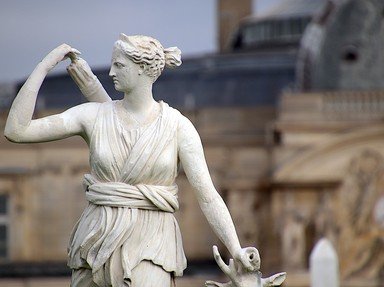Quiz Answer Key and Fun Facts
1. One of the earliest known sculptures is a small limestone figure found at a Paleolithic site in Austria in 1908. Dated about 30,000-25,000 BCE, the figure is thought to represent a goddess, perhaps of fertility or of Earth itself. By what name is this figure known?
2. By the time the famous bust of Queen Nefertiti was created in 1343 BCE, Egyptian sculpture had been in existence for thousands of years. What was the primary function of sculpture in ancient Egypt?
3. In 1974 workers digging a well uncovered the first glimpse in more than 2,200 years of a great artistic and historical treasure.
Archeological excavations of the site revealed not one sculpture, but about 7,000 life-size terra cotta figures; soldiers, commanders, horses and chariots, each one with a unique quality.
Where is the tomb this sculptured army has been silently guarding for more than two millennia?
4. The Greek geniuses Phidias (active c.493-c.430 BCE), Polykleitos (active c.450-c.420 BCE), and Praxiteles (400-330 BCE) abandoned the centuries-old sculptural tradition that limited figures to a stiff, strictly frontal view. Which of the following terms is strongly associated with Greek sculpture in the High and Late Classic periods?
5. Laocoön was an early 1st century Christian religious sculptor.
6. Which part of Vatican City's famous bronze statue of St. Peter Enthroned (5th or 13th century) has been worn away by the kisses of the faithful over the centuries?
7. In February 1978, a magnificent sculptured disk was rediscovered in Mexico. The subject was the goddess Coyolxauhqui, murdered and dismembered by her brother, the war god Huitzilopoxtli. The disk is thought to date from 1325-1521. How had it been lost for hundreds of years?
8. Which of the following Italian artists did NOT exert a strong influence on Michelangelo?
9. Giovanni Lorenzo (Gianlorenzo) Bernini thrived (creatively and financially) under the patronage of Pope Urban VIII and so might be said to be responsible for "urban renewal" in 16th century Rome. His sculptures are acknowledged to be the main reason Rome is known as "the city of fountains". For which of these notable works was Bernini NOT responsible?
10. Auguste Rodin, born in 1840, is thought by many to have been the last great realistic sculptor. After Rodin, sculpture became increasingly more abstract. Rodin's long career (he died in 1917) produced literally thousands of sculptures in marble, bronze, terracotta, plaster and other media. Some of Rodin's works met with mixed reviews when first exhibited. Which of the following is NOT a once-controversial work by Rodin?
Source: Author
LilahDeDah
This quiz was reviewed by FunTrivia editor
bloomsby before going online.
Any errors found in FunTrivia content are routinely corrected through our feedback system.
